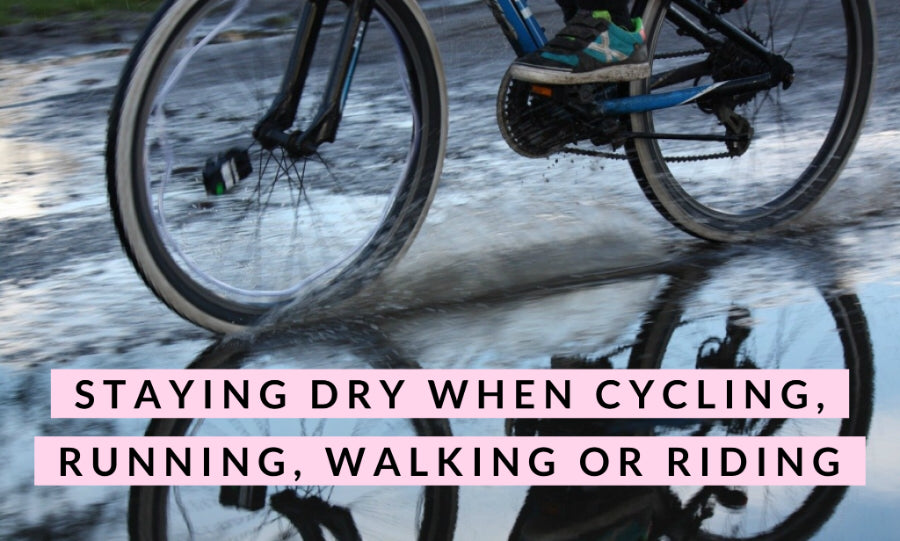Your Cart is Empty

Most of us like to get out and about us much as possible but the changeable British weather means that you can set out in the sun and, within a short distance, you’ll be facing clouds of rain.
But one of the things that makes us British is our ability to carry on in challenging conditions. And a large part of this is due to preparation!
Which is why being waterproof - or having the means to become waterproof! - is key to enjoyable outdoors exercise or the daily commute.
But what should you choose to keep yourself waterproof and what features are important in the quest to keep you dry?
What products are available, and what features are important?
Clothing - includes jackets and trousers
 |
 |
Depending on what time of year you’re exercising, you might opt for waterproof trousers and a jacket. When it’s warmer you probably won’t want the extra warmth that trousers provide and a jacket will probably suffice.
Not all jackets are completely waterproof; some are what we refer to as ‘showerproof’ or ‘water resistant.’ The difference being that the latter will provide some protection but not as complete as full on waterproof. The advantage of a showerproof/water resistant jacket is that the fabric it’s made from is breathable, which is not possible with a waterproof fabric.
If you decide that you do want a waterproof jacket, then make sure it has some means of ventilation so you don’t overheat. This might mean it has a mesh lining or vents in the back, sides or armpits. As with bike bags (see below), zips are also a consideration. You don't want your zip coming undone as you're travelling along so look for zips that prevent that from happening.
Another consideration might be that when it rains it tends to be darker, so visibility is an issue. Think about whether the jacket is highvis, reflective or both.
Bike bags
 |
 |
 |
 |
 |
As with clothing, there are both waterproof and water resistant bike bags, so bear in mind how important it is for your kit to be completely protected from the rain.
Not only does the material that the bike bag is made from need to be waterproof but the zips do too! What is the point of keeping the rain out on the sides only for it to be seeping in at the zips?! Don’t forget that the zips do need to be zipped up to retain their waterproof properties. You can find out more about zips here.
Of course if you have a bike bag already, or the one you fancy doesn’t have waterproof qualities, you can always get a waterproof cover.
Covers for your kit
 |
 |
 |
 |
If you’ve got things already but you want to make them waterproof rather than buy another one, covers are a great option. As mentioned above, there are waterproof covers for bike bags, as well as for rucksacks/ backpacks, helmets and the bike itself (when it’s static..!).
Backpack covers
If you decide that a backpack cover is what you need, make sure it’s easy to put on and take off, otherwise you’ll avoid using it. Also make sure that you put it on properly, so rain doesn’t get in around the side. These are a great item to have as most of us own a rucksack or two, and being able to make whichever you’re using waterproof is super-handy. Another advantage, other than keeping your bag dry and clean, is that they often come in highvis and/or reflective fabric, so you also have added visibility. Check the one you want has sealed seams as this is another area that can let rain in.
Helmet covers
There are very few, if any, waterproof helmets on the market which is why waterproof helmet covers are both useful and popular! As with the backpack cover, make sure the one you go for is easy to put on and take off, and why not get a high visibility one that makes you stand out a little more? They’re a great waterproof choice as they can be kept in your pocket ready for unexpected showers!
Bike covers
Finally, we want to quickly mention waterproof covers for your actual bike, rather than for you! If you’ve no garage or shed - or no space in one! - a waterproof cover is a perfect solution. Some go large enough to cover two bikes, or even a moped or motorbike, if powered two-wheelers are part of your life. As with other waterproof products, look out for sealed seams so drips don’t get in. Make sure the cover you choose is easy to both put on and off, as well as fix in place, so that wind doesn’t take it off. There are lots on the market which are not very waterproof and not very rip-proof so do check reviews before buying.
We hope we've given you some food for thought but if you've any questions relating to waterproof products, do drop us a lineand we'll be pleased to point you in the right direction.
Comments will be approved before showing up.